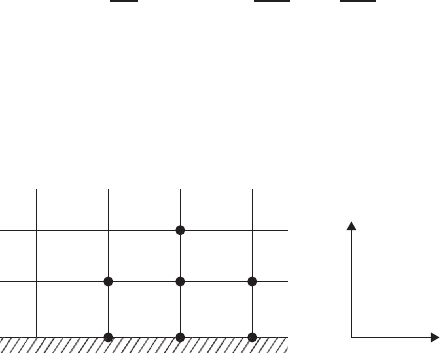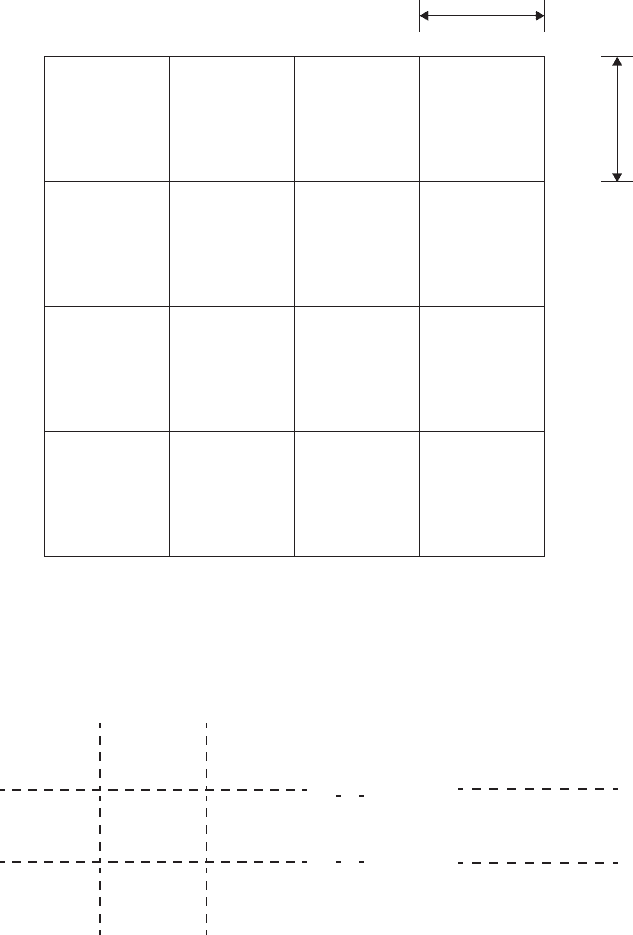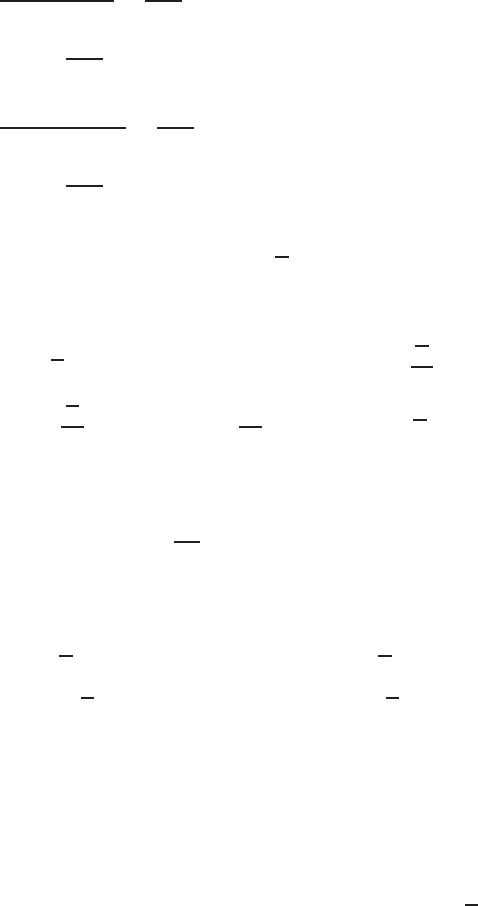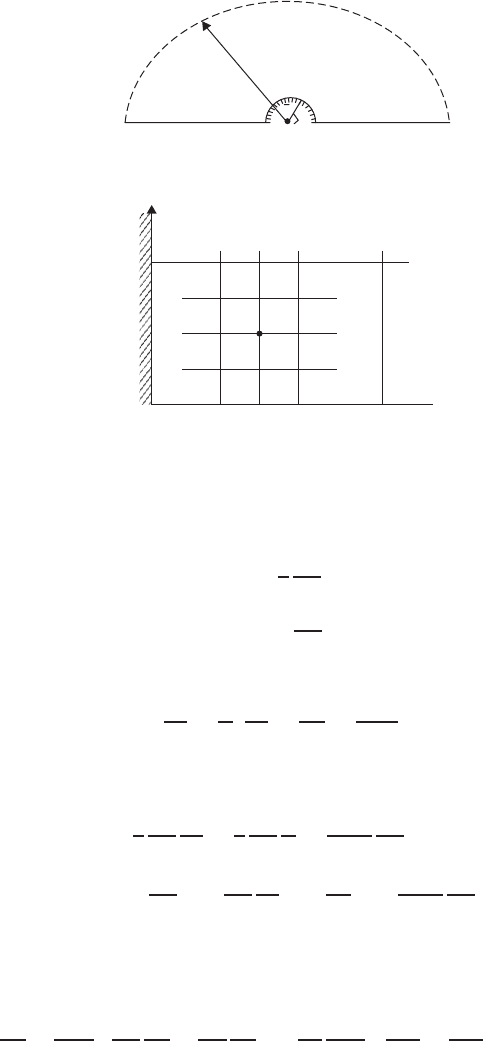Biringen S., Chow C.-Y. An Introduction to Computational Fluid Mechanics by Example
Подождите немного. Документ загружается.


282 NUMERICAL SOLUTION OF THE INCOMPRESSIBLE NAVIER-STOKES EQUATION
Equation (4.6.9) is the vorticity transport equation, in which the vorticity and the
velocity vectors are the unknowns. In two-dimensional flows the only nonzero
component of the vorticity is along the z direction, so that equation (4.6.9) is
written only for the z component of the vorticity, ω
∂ω
∂t
+u
∂ω
∂x
+v
∂ω
∂y
= ν∇
2
ω (4.6.10)
The velocities can be written in terms of the stream function
u =
∂ψ
∂y
, v =−
∂ψ
∂x
(4.6.11)
The substitution of (4.6.11) into the definition of vorticity, ω = ∂v/∂x − ∂u/∂y,
yields the elliptic stream function equation,
∇
2
ψ =−ω (4.6.12)
The system of equations (4.6.10) and (4.6.12) will be integrated for the two
unknowns, ω and ψ. Velocities can be updated by using (4.6.11). We discretize
these equations using the Euler explicit scheme for simplicity. Other integration
formulas, such as the implicit or semi-implicit time stepping schemes, can be
easily substituted for this scheme.
Let us now consider the wall-driven cavity problem outlined in Section 4.5.
We will use the vorticity/stream-function approach to obtain a solution for this
problem. It is possible to use a collocated mesh because the elimination of
the pressure gradient term obviates the use of a staggered mesh to strengthen
pressure–velocity coupling as in the primitive variable system (Section 2.5).
With second-order central differences and Euler-explicit time-advancement, the
finite-difference form of (4.6.10) is written as
ω
n+1
i, j
−ω
n
i, j
t
+u
n
i, j
ω
n
i+1, j
−ω
n
i−1, j
2h
+v
n
i, j
ω
n
i, j +1
−ω
n
i, j −1
2h
=
1
h
2
Re
ω
n
i+1, j
+ω
n
i−1, j
+ω
n
i, j +1
+ω
n
i, j −1
−4ω
n
i, j
(4.6.13)
We will assume that the variables have been nondimensionalized by U and L,
the lid velocity and the cavity height, respectively, so that Re = UL/ν;also,
h = x = y. Using the vorticity at the advanced time level (n + 1), the stream
function is calculated from the finite-difference form of (4.6.12):
ψ
n+1
i+1, j
−2ψ
n+1
i, j
+ψ
n+1
i−1, j
h
2
+
ψ
n+1
i, j +1
−2ψ
n+1
i, j
+ψ
n+1
i, j −1
h
2
=−ω
n+1
i, j
(4.6.14)
Equation (4.6.14) can be solved either by an iterative method or by a direct
method (LU decomposition). The velocity components are updated from (4.6.11):
u
n+1
i, j
=
ψ
n+1
i, j +1
−ψ
n+1
i, j −1
2h
, v
n+1
i, j
=−
ψ
n+1
i+1, j
−ψ
n+1
i−1, j
2h
(4.6.15)

FLOW PAST A CIRCULAR CYLINDER 283
The numerical integration is done according to the following sequence:
1. Set initial conditions at t = 0 (e.g., at all interior points set ω
n
i, j
= 0).
2. Calculate ω
n+1
i, j
at time level t +t from (4.6.13).
3. Obtain ψ
n+1
i, j
by solving (4.6.14) either by a direct method or iteratively.
4. Update velocities by calculating u
n+1
i, j
and v
n+1
i, j
from (4.6.15).
5. Boundary values for ω
i, j
are solution-dependent and must be updated at
every time step using ψ
n+1
i, j
. We suggest a way of doing that below.
6. If the computation has reached the desired time, or if a prescribed conver-
gence criterion is reached, terminate the calculation; otherwise, go back to
step 2.
7. Monitor the Courant number (which is solution-dependent) and if it starts
to increase rapidly, terminate the calculation and start over with half the
original time step.
For the driven-cavity problem, all boundary conditions are prescribed on
impermeable solid boundaries. Higher-order boundary conditions for vorticity
were developed in Section 3.7, equations (3.7.14) and (3.7.15). Here we provide
an alternative way of writing the boundary conditions for vorticity obtained from
the interior values of the stream function only in the wall-normal direction. Con-
sider Fig. 4.6.1, which shows the vertical grid layout close to the lower stationary
wall, where ψ
n+1
i,1
is the value of the stream function on the wall and ψ
n+1
i,2
is
the value of the stream function at the first point away from the wall; h = y is
the grid length. Using Taylor series up to second order, assuming y is small:
ψ
n+1
i,2
= ψ
n+1
i,1
+
∂ψ
∂y
n+1
i,1
y +
∂
2
ψ
∂y
2
n+1
i,1
y
2
2
+··· (4.6.16)
We now note that when there is no through flow, the boundary condition for the
stream function on solid wall is prescribed as
ψ
n+1
i,1
= 0
Δx
Δy
(i, j)
x(i)
y(j)
(i, 2)
(i, 1)
(i − 1, 2)
(i − 1, 1)
(i + 1, 2)
(i + 1, 1)
FIGURE 4.6.1 Grid arrangement close to the stationary lower wall.

284 NUMERICAL SOLUTION OF THE INCOMPRESSIBLE NAVIER-STOKES EQUATION
Also,
∂ψ
∂y
n+1
i,1
= u
n+1
i,1
= 0 (stationary wall, no slip boundary)
From the definition of vorticity,
ω
n+1
i,1
=
∂v
∂x
n+1
i,1
−
∂u
∂y
n+1
i,1
(4.6.17)
Imposing a no-slip boundary condition, we get
v
n+1
i,1
= 0sothat
∂v
∂x
n+1
i,1
= 0 (4.6.18)
It then follows from (4.6.17) that
ω
n+1
i,1
=−
∂u
∂y
n+1
i,1
(4.6.19)
Hence, (4.6.16) can be written as
ψ
n+1
i,2
=
∂
2
ψ
∂y
2
n+1
i,1
y
2
2
=
∂
∂y
∂ψ
∂y
n+1
i,1
y
2
2
=
∂u
∂y
n+1
i,1
y
2
2
=−ω
n+1
i,1
y
2
2
(4.6.20)
which leads to the boundary condition for vorticity on the stationary lower wall
of the cavity:
ω
n+1
i,1
=−
ψ
n+1
i,2
y
2
/2
(4.6.21)
Now, considering the upper wall (Fig. 4.6.2), where the grid index j = J ,and
using Taylor series as before, we have
ψ
n+1
i, J −1
= ψ
n+1
i, J
−
∂ψ
∂y
n+1
i, J
y +
∂
2
ψ
∂y
2
n+1
i, J
y
2
2
+··· (4.6.22)
(i − 1, J)
(i − 1, J − 1) (i + 1, J − 1)(i, J − 1)
(i, J)
(i, J − 2)
(i + 1, J)
FIGURE 4.6.2 Grid arrangement close to the moving upper wall.

FLOW PAST A CIRCULAR CYLINDER 285
Using the same arguments as before, on solid boundaries with no flow through,
ψ
n+1
i, J
= 0, and
∂ψ
∂y
n+1
i, J
= u
n+1
i, J
= u
W
= 1 (moving wall, no slip boundary) (4.6.23)
Using (4.6.17)–(4.6.19), (4.6.22) can be written as
ψ
n+1
i, J −1
=−
∂ψ
∂y
n+1
i, J
y +
∂
2
ψ
∂y
2
n+1
i, J
y
2
2
=−u
W
y − ω
n+1
i, J
y
2
2
(4.6.24)
from which we obtain
ω
n+1
i, J
=
−ψ
n+1
i, J −1
−u
W
y
y
2
/2
, u
W
= 1 (4.6.25)
Let us now consider the stream function equation (4.6.14) on a grid with 3 ×3
interior points shown in Fig. 4.6.3:
ψ
i+1, j
+ψ
i−1, j
+ψ
i, j +1
+ψ
i, j −1
−4ψ
i, j
=−h
2
ω
ij
i = 1, 2, ...N
j = 1, 2, ...NN= 3
(4.6.26)
Here, the first subscript is the column index along the x direction, and the second
subscript is the row index along the y direction. We can write (4.6.26) for each
internal node:
ψ
21
+ψ
01
+ψ
10
+ψ
12
−4ψ
11
=−h
2
ω
11
(1,1)
ψ
31
+ψ
11
+ψ
20
+ψ
22
−4ψ
21
=−h
2
ω
21
(2,1)
ψ
41
+ψ
21
+ψ
30
+ψ
32
−4ψ
31
=−h
2
f
31
(3,1)
ψ
22
+ψ
02
+ψ
11
+ψ
13
−4ψ
12
=−h
2
ω
12
(1,2)
ψ
32
+ψ
12
+ψ
21
+ψ
23
−4ψ
22
=−h
2
ω
22
(2,2)
ψ
42
+ψ
22
+ψ
31
+ψ
33
−4ψ
32
=−h
2
ω
32
(3,2)
ψ
23
+ψ
03
+ψ
12
+ψ
14
−4ψ
13
=−h
2
ω
13
(1,3)
ψ
33
+ψ
13
+ψ
22
+ψ
24
−4ψ
23
=−h
2
ω
23
(2,3)
ψ
43
+ψ
23
+ψ
32
+ψ
34
−4ψ
33
=−h
2
ω
33
(3,3)
(4.6.27)

286 NUMERICAL SOLUTION OF THE INCOMPRESSIBLE NAVIER-STOKES EQUATION
4, 43, 42, 41, 40, 44
3
2
1
01234
0, 3 1, 3
2, 3
3, 3 4, 3
4, 23, 22, 21, 20, 2
0, 1 1, 1 2, 1 3, 1 4, 1
0, 0 1, 0 2, 0 3, 0 4, 0
Δy
Δ
x
y(j)
x(i)
FIGURE 4.6.3 Computational grid for the ψ equation (4.6.26).
And in vector-matrix form,
⎡
⎢
⎢
⎢
⎢
⎢
⎢
⎢
⎢
⎢
⎢
⎢
⎢
⎢
⎣
4 −10−100000
−14−10−10000
0 −1400−10 0 0
−1004−10−100
0 −10−14−10−10
00−10−1400−1
000−1004−10
000 0−10−14−1
000 00−10−14
⎤
⎥
⎥
⎥
⎥
⎥
⎥
⎥
⎥
⎥
⎥
⎥
⎥
⎥
⎦
⎡
⎢
⎢
⎢
⎢
⎢
⎢
⎢
⎢
⎢
⎢
⎢
⎢
⎣
ψ
11
ψ
21
ψ
31
ψ
12
ψ
22
ψ
32
ψ
13
ψ
23
ψ
33
⎤
⎥
⎥
⎥
⎥
⎥
⎥
⎥
⎥
⎥
⎥
⎥
⎥
⎦
n+1
=−
⎡
⎢
⎢
⎢
⎢
⎢
⎢
⎢
⎢
⎢
⎢
⎢
⎢
⎢
⎣
−h
2
ω
11
+ψ
01
+ψ
10
−h
2
ω
21
+ψ
20
−h
2
ω
31
+ψ
30
+ψ
41
−h
2
ω
12
+ψ
02
−h
2
ω
22
−h
2
ω
32
+ψ
42
−h
2
ω
13
+ψ
03
+ψ
14
−h
2
ω
23
+ψ
24
−h
2
ω
33
+ψ
43
+ψ
34
⎤
⎥
⎥
⎥
⎥
⎥
⎥
⎥
⎥
⎥
⎥
⎥
⎥
⎥
⎦
n+1
(4.6.28)
The problem again reduces to the solution of the linear equation:
A = f

FLOW PAST A CIRCULAR CYLINDER 287
where A is the banded N
2
×N
2
(9 × 9) coefficient matrix; the number of nonzero
bands is 2N +1. We can also write (4.6.28) as follows:
⎡
⎣
BI0
IBI
0IB
⎤
⎦
⎡
⎣
ψ
i1
ψ
i2
ψ
i3
⎤
⎦
=
⎡
⎣
f
i1
f
i2
f
i3
⎤
⎦
, i = 1, 2, 3
wherewedefineI as the 3 × 3 identity matrix and B is the partitioned diagonal
matrix of A. The direct solution of the linear system A = f can be efficiently
done by the LU decomposition method, where we decompose A into a special
upper triangular matrix U and a lower triangular matrix L with the diagonal equal
to unity. The sequential solution of this system is the same as the solution of
the tridiagonal matrix equation given by (4.4.45)–(4.4.46). In a similar fashion,
when the problem requires successive solutions of the elliptic equation, the LU
decomposition can be done only once and storing the L and U matrices, the
back substitution can be performed as many times as needed, thus reducing the
required computational effort. These savings are possible because the cost of the
solution of an n system of linear equations by the LU decomposition method
is n
3
/2 operations, the same as in Gaussian elimination, but the backsubstitu-
tion part is only n
2
operations (Ferziger, 1998, p. 5). We also note that for the
ω–ψ formulation of the governing equations, there is no singularity in both the
coefficient matrix of the spatially elliptic ω equation and the coefficient matrix
of the the elliptic ψ equation, so that both can be solved by iterative methods,
such as the successive overrelaxation (SOR) method outlined in Section 2.8,
(2.8.13)–(2.8.14).
Another iterative method that can be efficiently employed for the solution
of elliptic equations is the alternating-direction implicit (ADI) method. Let us
consider the elliptic Laplace equation for a generic variable T, in a rectangle
0 < x, y < 1, with Dirichlet boundary conditions on all the sides:
∂
2
T
∂x
2
+
∂
2
T
∂y
2
= 0 (4.6.29)
The ADI method assumes a pseudo time derivative, so that the equation becomes
elliptic in space and parabolic in time, e.g.,
∂T
∂t
=
∂
2
T
∂x
2
+
∂
2
T
∂y
2
(4.6.30)
and seeks steady-state solutions for this problem as t →∞.
Thus, the use of the ADI method for elliptic problems implies that
• Physical significance and the accuracy of the transient solution are not of
interest.
• As steady state is approached, that is, when t →∞, the solution approaches
that of the elliptic Laplace (or Poisson) equation.

288 NUMERICAL SOLUTION OF THE INCOMPRESSIBLE NAVIER-STOKES EQUATION
As the transient solution is not important, it is generally sufficient to advance
the solution in time using the fully implicit Euler scheme, so that the two-step
procedure of this method can be written as (Peaceman and Rachford, 1955)
T
n+1/2
i, j
−T
n
i, j
t
1
=
1
x
2
T
n+1/2
i+1, j
−2T
n+1/2
i, j
+T
n+1/2
i−1, j
+
1
y
2
T
n
i, j +1
−2T
n
i, j
+T
n
i, j −1
T
n+1
i, j
−T
n+1/2
i, j
t
1
=
1
x
2
T
n+1/2
i+1, j
−2T
n+1/2
i, j
+T
n+1/2
i−1, j
+
1
y
2
T
n+1
i, j +1
−2T
n+1
i, j
+T
n+1
i, j −1
(4.6.31)
Defining
β
r
= x/y, ρ = x
2
/t
the iteration sequence can be written as
T
n+1/2
i+1, j
−(2 + ρ)T
n+1/2
i, j
+T
n+1/2
i−1, j
= β
2
r
−T
n
i, j +1
+
2 −
ρ
β
2
r
T
n
i, j
−T
n
i, j −1
T
n+1
i, j +1
−(2 +
ρ
β
2
r
)T
n+1
i, j
+T
n+1
i, j −1
=
1
β
2
r
−T
n+1/2
i+1, j
+(2 −ρ)T
n+1/2
i, j
−T
n+1/2
i−1, j
(4.6.32)
Now considering the Poisson equation,
∂T
∂t
=∇
2
T −ξ(x, y) (4.6.33)
where ξ(x, y) is the source term. For x = y (β
r
= 1), the ADI sequence can
be written as
T
n+1/2
i+1, j
−(2 +ρ)T
n+1/2
ij
+T
n+1/2
i−1, j
=−T
n
i, j +1
+(2 − ρ)T
n
ij
−T
n
i, j −1
−x
2
ξ
i, j
T
n+1
i, j +1
−(2 +ρ)T
n+1
ij
+T
n+1
i, j −1
=−T
n+1/2
i+1, j
+(2 −ρ)T
n+1/2
ij
−T
n+1/2
i−1, j
−y
2
ξ
i, j
(4.6.34)
Both set of equations (4.6.32) and (4.6.34) are solved first along rows and next
by columns. In both steps, the resulting system of linear equations has tridiagonal
coefficient matrices so that either the Thomas algorithm or the LU decomposi-
tion can be very efficiently implemented. It is important to recognize that the
speed of solution convergence depends strongly on the choice of the iteration
parameter, ρ. This method will converge for any fixed value of
ρ for Laplace’s

FLOW PAST A CIRCULAR CYLINDER 289
equation in a square, provided that the same value is used in the two half-steps.
More information concerning different formulations of the ADI method and the
selection of the iteration parameter are given in Mitchell (1969).
Project for Further Study: Program 4.4 is a MATLAB script that numerically
integrates (4.6.10) and (4.6.12) with the Euler explicit scheme on a uniform mesh
with x = y. The solution of the elliptic stream function (ψ) equation (4.6.12)
is obtained by the SOR method. Modify the program and solve (4.6.12) using the
Peaceman-Rachford ADI method outlined above for a grid of 31 ×31 interior
grid points at Reynolds numbers Re = 1, 100, and 400. Note that this equation
has to reach a converged state at every time step during the integration process
and the rate of convergence strongly depends on the proper choice of the iteration
parameter, ρ; for practical purposes, setting ρ ≈ 8/N is sufficient (Ferziger,
1998, p. 265). A parameter sequence for the Peaceman-Rachford method is given
by Wachpress (1957) and summarized by Mitchell (1969, p. 111), which reads
r
k+1
= (1/ρ
k+1
) =
1
2cos
2
(π/2M )
cot
2
π
2M
k/(k
0
−1)
(k = 0, 1, ..., k
0
−1)
(4.6.35)
In (4.6.35), M is the number of grid divisions so that (M −1) is the number of
interior grid points in one direction. Also, k
0
is the smallest integer greater than
or equal to 2, obtained from
√
2 − 1
(k
0
−1)
≤ tan
π
2M
(4.6.36)
It is important to use the same value of
ρ
k
n each half step of the integration
process. Assuming a 10 ×10 grid of interior points, M = 11, and from
(4.6.36) one obtains k
0
= 4, which leads to the following sequence of r-values:
0.51033610, 1.85949096, 6.77535187, and 24.68707504. The parameter
sequence can be applied as many times as needed until the imposed convergence
criterion (for example, three orders of magnitude decrease on the amplitude of
the initial error norm) is satisfied.
Compare the convergence rates of the solution at different Re, when using
these two convergence criteria.
Flow Past a Circular Cylinder
As a final example, we will consider uniform flow, U
∞
, past a circular cylinder
with radius a as shown in Figure 4.6.4. We follow the formulation of this problem
outlined by Peyret and Taylor (1983, pp. 207–212) and, defining the diameter-
based Reynolds number, Re = 2Ua/ν, we write (4.6.12) and (4.6.9), respectively,

290 NUMERICAL SOLUTION OF THE INCOMPRESSIBLE NAVIER-STOKES EQUATION
d
U
∞
L
FIGURE 4.6.4 Geometry of flow past a circular cylinder, where d is the cylinder diameter,
and L is the separation bubble length.
in cylindrical coordinates:
∂
2
ψ
∂r
2
+
1
r
∂ψ
∂r
+
1
r
2
∂
2
ψ
∂θ
2
=−ω (4.6.37)
∂ω
∂t
+v
r
∂ω
∂r
+
v
θ
r
∂ω
∂θ
=
2
Re
∂
2
ω
∂r
2
+
1
r
∂ω
∂r
+
1
r
2
∂
2
ω
∂θ
2
(4.6.38)
where v
r
and v
θ
are the velocity components along the radial (r) and tangential
(θ) directions, respectively.
The problem consists of the cylinder in quiescent air for time t < 0. At time
t ≥ 0, a uniform velocity U
∞
is applied. The unsteady Navier-Stokes equations
are solved with no-slip boundary conditions on the surface boundary, ,andthe
boundary r →∞has uniform flow. The flow remains symmetrical with respect
to the centerline for low Reynolds numbers, Re < 40. For higher values of Re,
the solution rapidly bifurcates into an oscillatory regime. We will consider low
Re cases exploiting the symmetry of the solution, and investigate the effects of
increasing values of Re on the separation bubble length (L/d) and the drag force
on the cylinder.
It is apparent from the above statements that one major difficulty of this
problem is the unbounded physical domain. This difficulty can be resolved by
mapping the infinite extent of the physical domain in the r coordinate into a
finite computational domain by an algebraic transformation given by Ta Phuoc
Loc (1980), such that
r =
r
a
= e
πξ
θ = πη
(4.6.39)
In (4.6.39),
r is the dimensional radius. Because of the symmetry of the solution
at low Re < 40, it is sufficient to calculate the flow field in the upper half
of the computational domain, i.e., for 0 ≤ θ ≤ π,sothat0≤ η ≤ 1. Also, the
computational domain is limited to a finite value ξ
∞
1, which is equivalent to
r
∞
= 22, sufficiently removed from the surface of the cylinder (Figure 4.6.5).

FLOW PAST A CIRCULAR CYLINDER 291
r, θ
θ
C
BA
D
CB
A
i, j
0
D
r
∞
= 22
η(i)
ζ(j)
ξ
∞
a
FIGURE 4.6.5 Cylinder in uniform flow in transformed coordinates.
In cylindrical coordinates, velocity components are given as
v
r
=
1
r
∂ψ
∂θ
,
v
θ
=−
∂ψ
∂r
(4.6.40)
Also noting that
∂η
∂θ
=
1
π
,
∂ξ
∂r
=
1
πr
=
e
−πξ
π
(4.6.41)
(4.6.40) can be transformed into the new variables by (4.6.41):
v
r
=
1
r
∂ψ
∂η
∂η
∂θ
=
1
r
∂ψ
∂η
1
π
=
1
πe
πξ
∂ψ
∂η
(4.6.42)
v
θ
=−
∂ψ
∂r
=−
∂ψ
∂ξ
∂ξ
∂r
=−
1
πr
=−
1
πe
πξ
∂ψ
∂ξ
(4.6.43)
Substituting (4.6.39)–(4.16.43) into (4.6.37) and (4.6.38), we obtain the govern-
ing equations in the transformed ξ −η coordinates:
∂ω
∂t
+
1
g(ξ )
∂ψ
∂η
∂ω
∂ξ
−
∂ψ
∂ξ
∂ω
∂η
=
2
Re
1
g(ξ )
∂
2
ω
∂ξ
2
+
∂
2
ω
∂η
2
(4.6.44)
